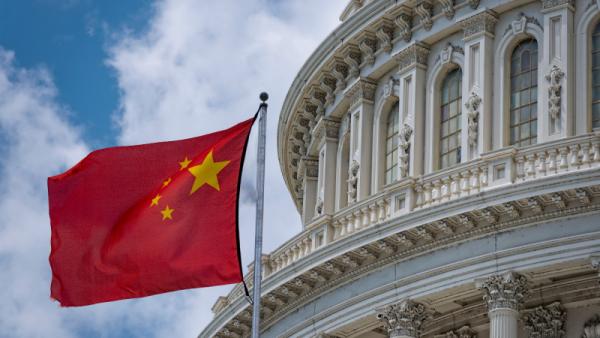Behind the ‘Red Curtain’: Decoding China’s institutional logics
Andrea Izzotti / Shutterstock

Marina Yue Zhang, Associate Professor – Research, Australia-China Relations Institute, University of Technology Sydney |
This article appeared in Pearls and Irritations, a public affairs blog, on August 28 2023.
Over the past three decades, Australia’s economic growth owes much to China’s voracious demand for natural resources. However, beneath this symbiotic economic relationship lies a complex web of political and geostrategic considerations.
Australia, characterised by its vast terrain, sparse population, and geographic isolation, has long grappled with a sense of vulnerability. Historically, this vulnerability has driven the nation to seek security through alliances, first with the United Kingdom and now with the United States.
When China and the United States enjoyed positive relations, Australia skillfully managed its ties with both nations, capitalising on the power balance between these superpowers for national security and economic opportunity. However, with escalating tensions between China and the US, Australia’s ability to maintain this delicate balance is diminishing, resulting in heightened tensions with China. Australia’s enduring alliance with Washington appears to foster an increasingly deep sense of mistrust with Beijing.
This growing mistrust is not devoid of context. The US views China’s rise, particularly in advanced technologies that can redefine global economic and military power, as a substantial threat. Simultaneously, China’s assertive diplomatic approach has placed it on a collision course with the West. Consequently, Western perceptions of China focus on what Mike O’Sullivan of Forbes magazine calls its ‘red curtain’ – encompassing its communist ideology and one-party rule, implying aggression and menace. This portrayal unfairly categorises China together with autocratic regimes such as Russia, Iran, and North Korea, creating an oversimplified characterisation that overlooks the intricate dynamism that forms the foundation of the complexity within Chinese politics, economy, and society.
Australia, advocating the US-led international order for regional peace and stability, now faces the challenge of a shifting global power balance catalysed by China’s ascent. Australia’s foreign policy toward China has undergone a subtle yet pivotal transformation since 2017. On one hand, it has introduced a political dimension to trade considerations by invoking national security concerns to reject Chinese investments and limit Chinese involvement in ‘security’ projects. On the other hand, Australia has vocally decried what it sees as economic coercion from China, positioning itself as a victim in these dynamics.
China’s rise undeniably challenges the technological supremacy of the US, prompting Washington’s containment strategy in dealing with Beijing. However, pinpointing specific actions, policies, or moments that inherently threaten Australia’s national security is a complex endeavour. Under the Albanese government, Australia-China relations are inching toward stabilisation, yet undercurrents of mistrust persist as ‘hawkish’ perspectives continually infiltrate Australian media, influencing public perceptions of China.
Instead of simply aligning its interests with the US, it is critical for Australia to find a new balance in the great power rivalry and to develop its own strategic approach toward China. Among other things, this will require an understanding of how policy is formulated behind China’s ‘red curtains’.
China’s institutional dynamics are far more intricate than they may appear on the surface. Policymaking within China involves a multifaceted power struggle among its multi-institutional logics. Beyond the central dichotomy of state versus market that shapes China’s developmental trajectory, leaning toward socialism or capitalism, as I have written elsewhere, China’s multi-institutional logics encompass a complex interplay involving diverse interest groups, negotiations between central and local authorities, considerations of domestic and international affairs, nuanced interpretations encountered during policy implementation across different levels of state and government structures, and finding common ground in a deeply divided society. These inherent contradictions deeply penetrate Chinese society, separating Chinese along lines of urban or rural residency, in or out of state-run organisations or entities, educational background, levels of urbanisation, and even generational disparities.
Navigating this intricate web of institutional logics carries profound implications. The fluid nature of this equilibrium, influenced by shifting power dynamics within the Chinese Communist Party (CCP), poses significant challenges to China’s economy, society, and foreign policy. For instance, this volatility is reflected in China’s evolving diplomatic posture and the fluctuations in the position of its senior diplomats in recent times.
Historically, China’s foreign policy was predominantly driven by the Party’s authority; however, this began to shift when China joined the WTO, initiating broader interactions with foreign entities. For decades, its foreign policy strategy was characterised by a low profile and a conciliatory stance, aimed at allaying global concerns about its rising influence. Notably, diplomats began seeing themselves not just as Party functionaries, but as seasoned professionals with independent roles.
As I wrote in an article for The Conversation in November 2022, a pronounced shift emerged in 2017 with China’s assertive ‘wolf warrior’ diplomacy, coinciding with President Xi Jinping’s second term. Graham Allison has noted that this tenure is marked by ambitions to elevate China as a global powerhouse. Prior to this shift, the West had predominantly perceived China’s rise through a lens of optimism, expecting greater political openness, adherence to the rule of law, and a pro-market economic orientation.
China’s enactment of the ‘Foreign Relations Law’ on July 1 has legitimated this strategic shift, signalling the country’s official embrace of an assertive stance of ‘struggle’ against perceived threats to its interests. For Chinese diplomats, this shift places a spotlight on Party loyalty, overshadowing traditional diplomatic roles characterised by accommodation.
From a bureaucratic viewpoint, this legislation underscores China’s transition from ‘national’ organisations or government entities to ‘central’ structures interwoven within its governance. In the Chinese political lexicon, the term ‘central’ typically connotes a Party structure. This development raises pertinent questions: What will be the impact of this change on China’s global engagement, and how should the West strategically respond?
China’s foreign policy mirrors the way it deals with domestic matters. China presently confronts unprecedented domestic challenges that have led to a notable shift towards heightened central control and centralised policymaking. Since the post-Mao era, the CCP’s legitimacy has hinged on sustained economic growth. When this foundation wavers, apart from embracing greater domestic control, adopting a more assertive stance towards foreign ‘challengers’ serves as another tool to preserve the Party’s legitimacy. Ultimately, few strategies rival the effectiveness of an external threat in maintaining internal unity in China.
Amid escalating China-US tensions, especially in technological domains such as clean energy transition, so-called ‘third power’ nations such as Germany, South Korea, and Australia are recognising the impracticality of a complete decoupling from China. Facing such geopolitical complexity, these nations need to carefully consider their options when making strategic moves in their engagement with China.
The bilateral relationship between the US and China is of paramount global significance. The efficacy of global collaboration pivots on the ability of these two powers to find common ground. Agreement between them substantially enhances the prospects of broad international accords, while their divergence often stifles progress in global cooperation.
Encouraging China to uphold the role of a responsible stakeholder requires consideration not only of the two superpowers and the third nations involved, but also of humanity as a whole. Such an approach could be pivotal in sustaining global stability and promoting sustainability. Innovative cooperation models, particularly in research, innovation, climate change, and disarmament, are critical for all nations, but for ‘third power’ nations, maintaining neutrality can prove more difficult than simply choosing a side between the two superpowers.
Australia’s bilateral relationship with China is a nuanced blend of opportunities and mistrust. Already, some years ago, Stephen FitzGerald, Australia’s first ambassador to China, underscored the need for Australia to position itself within a ‘Chinese world‘ and prioritise its relations with Beijing. While this advice remains relevant, its success hinges on a comprehensive understanding of China’s institutional dynamics and a skillful response to the rapidly evolving geopolitical landscape, going beyond merely accommodation of China’s needs or alignment with the US.
Moving forward, Australia’s relationship with China will sail through uncharted waters. The trajectory of Australia-China relations hinges significantly on the decisions Australia makes and its confidence in charting its own developmental course, within a framework of global stability and sustainable growth. The urgency for a balanced, pragmatic, and forward-thinking approach has never been more critical.
Author
Dr Marina Yue Zhang is Associate Professor – Research at the Australia-China Relations Institute, University of Technology Sydney.

